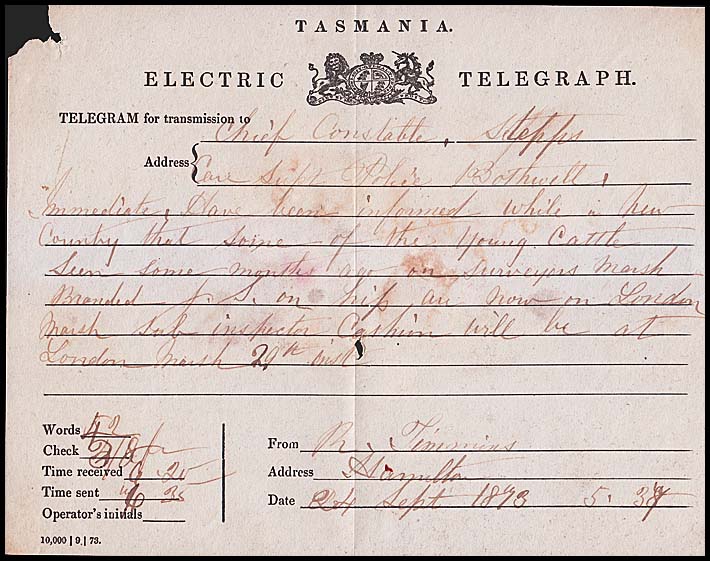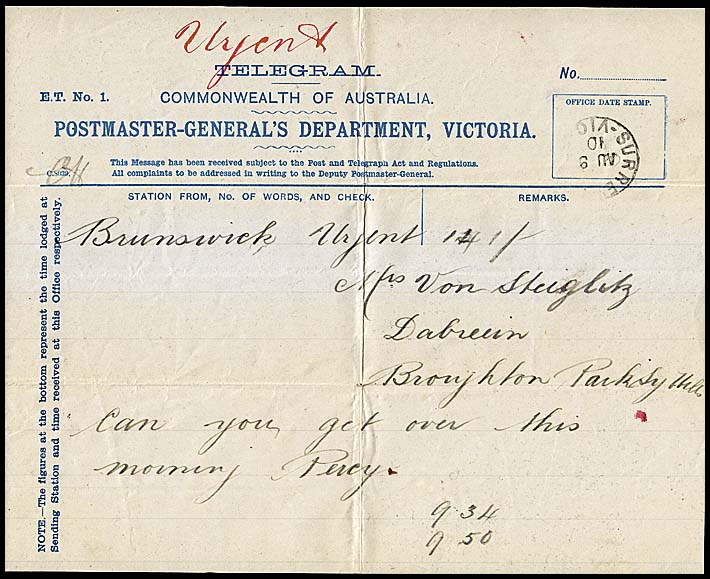Approaches by Colonial Telegraph Administrations.
- Home, index, site details
- Australia 1901-1988
- New South Wales
- Overview of NSW
- Telegraph lines
- Telegraph Offices
- Date stamps
- Forms
- Envelopes
- Rates
- Stamps
- Queensland
- Overview of Qld
- Telegraph lines
- Telegraph offices
- Date stamps
- Forms
- Envelopes
- Rates
- Stamps
- South Australia
- Overview of SA
- Telegraph lines
- Telegraph Offices
- Date stamps
- Forms
- Envelopes
- Rates
- Stamps
- Tasmania
- Overview of Tasmania
- General developments
- Reports
- Organisation
- Telegraph lines
- Telegraph Offices
- Date stamps
- Railway lines
- Forms
- Envelopes
- Rates
- Stamps
- Overview of Tasmania
- Victoria
- Overview of Vic.
- Telegraph lines
- Telegraph offices
- Date stamps
- Forms
- Envelopes
- Rates
- Stamps
- Ephemera
- Western Australia
- Overview of WA
- Telegraph lines
- Telegraph Offices
- Date stamps
- Forms
- Envelopes
- Rates
- Stamps
The way in which URGENT rate telegrams were introduced in the Australian colonies is unclear. Reports provide contradictory statements of the attitudes and actions taken. Developments are listed under:
- Queensland - the only Colony with firm evidence of having an Urgent Rate;
- Tasmania;
- Western Australia;
- Inter-Colonial Conferences;
- Australia in the early years of Federation.
On 13 March 1880, the Brisbane Courier reported a Government decision as follows: "It is notified for general information that the system of urgent telegraphic messages has been extended to the transmission of telegraphic money-orders. Orders advised by urgent telegram will therefore obtain precedence over all other money orders sent by wire, double rates being charged".
A note in the Brisbane Courier of 14 September 1882 reports on the meeting of the Brisbane Chamber of Commerce. The Under-Secretary of the Post and Telegraph Office had written in reply to the Chamber as follows: "the New South Wales and Victorian departments had been addressed early in 1881 on the subject of "urgent" telegrams, but they had declined to introduce the system". Nothing more can be located on the subject.
At least by 1893 and almost certainly by 1891, Queensland had issued a special URGENT delivery form (see QC-DU-1).
The Brisbane Courier of 13 January 1890 reported: "A number of reforms were introduced in the management of the Victorian Post and Telegraph Department at the beginning of the new year. The extension of the penny postage system to all parts of the colony already adverted to, has been roughly estimated to involve a loss of £100,000 to the Post Office for the first year. Among other alterations noted are some which may recommend themselves as worthy of adoption in this colony.
For instance, under our present arrangements, a telegram cannot be sent from Brisbane to an address in the suburbs unless there happens to be a telegraph office in that particular suburb and the telegraph office happens to be open at the time. It frequently occurs that persons require to send, from one part of Brisbane to another after 6 p.m., a message for the delivery of which they would be quite willing to pay telegraphic charges; but they are not permitted to do so unless they can secure the passage of their message over the wires from one telegraph office to another. A case of this kind was reported in these columns some months ago. It was desired to send a telegram from the Central Office to the West End one evening and the sender was obliged to walk out to the Roma Street station and telegraph the message back to the head office before it could be delivered.
In Victoria now, letters bearing 6d. postage and marked urgent will be treated as telegrams and delivered with the utmost despatch. Provision has also been made for the "transmission of telegrams by telephone". It is announced that subscribers to telephone exchanges will be allowed this privilege on payment of five guineas per annum and must advance a certain sum of money monthly, or more frequently if necessary, to cover the probable cost of the telegrams. At the option of subscribers, the messages will also be communicated by telephone to the persons to whom addressed, but copies of all such telegrams will, at the same time, be posted for delivery to their address and will be stamped on the face with the words "Transmitted by telephone". It is thought that business people will find an advantage in being able to dictate their telegrams direct to the telegraph office. Instead of having to write them out and send them by message to the office, they will simply "ring up" the telegraph office, communicate the message, and have it sent on by telegram immediately.
This system is not likely to recommend itself for adoption here for some time at least. Telephones in the Victorian capital are either of a better pattern or better looked after than ours, and a Melbourne businessman might, with safety, carry through telephonic feats which would make his Brisbane friends shudder to think of. Anyone here would write a fifty word message and take it to the office himself rather than attempt to shout it over the wires of the Brisbane Telephone Exchange. Whilst noting the progress of our neighbours in these particulars, it is interesting to observe that in one respect at least we have been in advance of them. The system of urgent telegrams for transmission within the colony, which has been in operation here just ten years, came into operation in Victoria on the 1st instant (January 1890)".
There is a reference to urgent rate telegrams in Tasmania in 1886 by Vindicator.Prior to that, a manuscript annotation was used by some to expedite the sending of a particular message.
 |
Rather than use URGENT, the word IMMEDIATE was often preferred.The 1873 telegram shown at the left has that as the first transmitted word.
Used on a Colonial period Tasmanian delivery delivery form (TC-DO-3). |
Also for Tasmania, the Victoria Camperdown Chronicle of 8 February 1895 reported "The postal authorities have arranged that the urgent telegram system, which is already in force between this colony, New South Wales, Queensland and South Australia, shall be extended to Tasmania. The ordinary rate for telegrams to that colony it 2s for 10 words and 2d for each additional word, and the urgent rate will be double this. Telegrams marked URGENT will receive precedence over ordinary messages. New Zealand and Western Australia are now the only colonies to which this system does not extend".
Western Australia honoured the type of telegram from other Colonies but did not offer the urgent service. For example, the South Australian Chronicle of 2 February 1890 reported that: "in consequence of the congested state of traffic on the inter-colonial telegraph lines of West Australia, the Postal Department of that colony has decided to suspend the regulations respecting urgent messages. These messages will not be accepted in West Australia and will not be granted priority. It will therefore be useless to send messages at the 'urgent' rate with the object of securing more rapid transmission".
See further details of the confused position in Western Australia elsewhere.
See Intercolonial Postal Conference of Feb./March 1890 for discussion of Urgent telegrams. In May, on the resumption of the Conference, the following is listed under
INTERCOLONIAL URGENT TELEGRAMS.
Mr. Powers moved: "That it is considered desirable to adopt a system of urgent telegram at double rates locally and inter colonially. In Queensland, he said, the system was adopted as far back as 1880, and it worked very well. The Post Office authorities would no more think of abolishing the urgent telegram system than they would think of raising the rates of telegrams. No complaint had ever been made against the system, which had really worked admirably from the time it had been started. Queensland had tried to get it adopted in the other colonies but were unsuccessful, except in Victoria, which colony had lately agreed to work with Queensland. To some extent, they were hindered by the objection New South Wales had taken to urgent telegrams passing through the colony. He thought it would benefit Australia generally if the system was adopted. At the conference in 1888, held in Sydney, the system was adopted by the majority, the discontents being New South Wales and South Australia.
Mr. Bird replied and said Tasmania had adopted the system and he would be glad to see it extended to all the colonies.
Mr. O'Connor said he had opposed the system, because he regarded every telegram in itself as important. However, he would not stand in the way of unanimity on the question.
The President said Adelaide was not prepared to stand out, seeing the position taken by the other colonies.
The motion was carried unanimously and the Proceedings of March 1890 recorded the following:
The system of "urgent messages" was very carefully considered. At the Conference held at Sydney in 1888 all the colonies except New South Wales and South Australia agreed to adopt the system, and it has been introduced within and between Victoria, Queensland, Tasmania, and Western Australia, and accepted by the Eastern Extension Telegraph Company so far as the New Zealand and Bass Straits cables are concerned, but New South Wales and South Australia still decline to fall in with the arrangement.
We can only report that we have been unable to arrive at any unanimous agreement on the subject.
Intercolonial Conference March 1898:
Mr. Cook (NSW) moved that a system of an urgent rate for Inter-Colonial and International urgent telegrams should be abolished. He argued that it was an unfair system to the general public. Mr. Duffy (Victoria) seconded the motion pro forma. An amendment to refer the matter to the permanent head of the Postal Department was agreed to (Resolution 87).
Resolution 89 as also discussed - that "Urgent Telegrams be on distinctly coloured forms". The matter was not discussed as the view was that it "can be dealt with departmentally". Clearly the matter of Urgent rate telegrams was a confused and nebulous matter and probably better left to after Federation.
Rates for URGENT messages were introduced at double the normal rate by the Post and Telegraph Rate Act of 1902. Prior to that, no Colony had had a special URGENT rate and most references to the transmission of telegrams stipulated that messages would be transmitted in order of receipt unless under special circumstances.
To indicate special circumstances, a sender could either include an indicative warning at the beginning of a message or plead with the officer in the Telegraph Office and explain why a message was of an urgent nature.
Hence a number of telegrams are found with an appropriate indicator which could be referenced by an operator or by a messenger. A typical example of these indicators is shown below.
 |
Use of mss. URGENT written by an official in the receiving station. The message incorporates the word URGENT in the address.
Used on an Interim period Victorian delivery form |
There were constant difficulties with urgent rate telegrams after their introduction and complaints in the press were numerous in both the Colonial and the Australian eras. For example, see the outcry about a telegram to Manly, NSW.